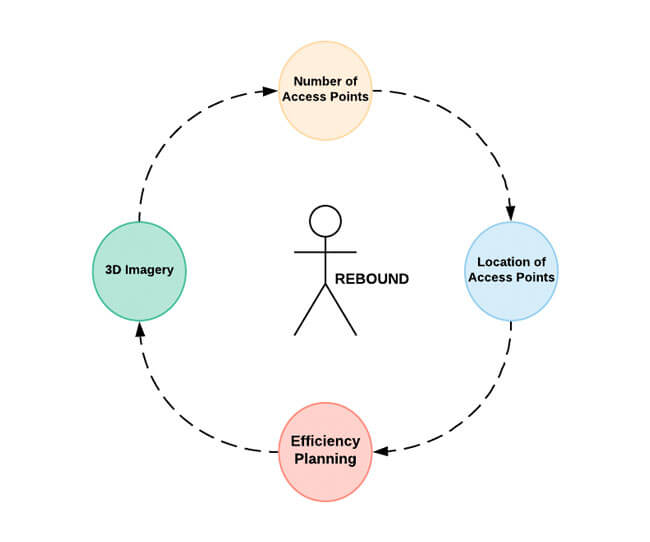Over the last two decades, technology has paved the way for humans to create tools and resources that made our lives easier, safer and healthier. From house-cleaning robots and voice assistants, to advances in health screening and detection techniques, technology has created a positive impact in our lives. However, there are still some key areas that can benefit from technology’s rapid growth and an increase in available data—in particular, how we prepare for natural disasters and provide post-disaster support. This article focuses on how technology and CoreLogic data can help communities plan and remain resilient after a natural disaster or pandemic.
Disaster Readiness
Planning plays an important role in revitalizing impacted communities. Each city and county must create a disaster response plan, which must be periodically updated. These plans should include setting up access points for providing food throughout the disaster area, how and where to obtain medical supplies and providing other services to impacted communities and locales.
Prioritizing locations with higher risk and expediting readiness efforts is a key to any readiness planning, especially when working with resource and/or budget constraints. CoreLogic’s “Storm Surge Risk Analysis” is a predictive model that can identify locations with higher risk, which will be pivotal to prioritize readiness planning. For ex: The model predicts Miami to be the location with the highest number of single-family homes at risk of storm surge in 2020.

Number of Access Points
Based on the type (e.g. hurricane, flood, tornado, earthquake or forest fire) and category of disaster, CoreLogic can develop algorithms and simulations to analyze the necessary resources to provide relief to a region. Analyses are based on property information CoreLogic possesses and population data from the U.S. Census. With this data, CoreLogic can determine the number of access points needed for a region. For densely populated areas, multiple access points must be placed in a small geographical area. The exact number of access points will need to be calibrated based on several other region and property attributes.
Location and Proximity of Access Points
The next step in planning is determining the type of properties in the region that can serve as potential access points. Access points can be chosen from a list of available facilities in the affected region and may include schools, educational facilities, stadiums and hospitals. Property attributes provided by the CoreLogic Property API like the property’s square footage, type of air conditioning etc. are valuable in assessing, not only the viability of the location to be an access point but also in gauging the capacity of people it can serve. From there, CoreLogic can leverage machine learning capabilities that can be used to provide a list of suitable properties in each region.
CoreLogic’s parcel-based geocoding technology known as PxPoint will help strategically place the access points. PxPoint can spatially partition the affected region into several smaller, geographically equal regions, or regions of equal population. The access points can then be set up at the closest facility to each geometric center, thus minimizing the distance the affected population must travel to get to the access point.
Efficiency Planning and Use of 3D Imagery
Google Earth is the most photorealistic, digital version of Earth which is created by first taking several overlapping 3D pictures of a street view which are then put together using photogrammetry. Google Earth’s 3D imagery gives users the ability to zoom in on a location in the street view. This technology is valuable in the planning stage, as it can be leveraged in planning the entry and exit routes for transporting supplies to an access point. Using 3D imagery, CoreLogic can essentially help examine and plan site logistics without needing to be physically present at the location. Ultimately, this tool will help to drastically reduce the time it takes to execute services and aid at a given location.
Emergency Alerts, Relief & Recovery:
Using CoreLogic’s location accuracy tools in conjunction with weather verification services, we can determine the exact location and the severity of the impact. CoreLogic’s tornado verification model combines radar data and public/social media reports to produce an actual tornado path with 250-meter resolution and neighborhood-level details, across most of the country. This will enable us to accurately send alerts to specific geographic regions via cellular carriers that broadcast messages to smartphones. These alerts will warn people of an approaching hurricane or tornado and help save lives and property.
How quickly can communities recover from disaster? How do local businesses begin the process of rebuilding? The answer depends on how streamlined post-disaster support is.
Technology can drive faster and efficient ways of providing aid and support to impacted populations, following a natural catastrophe. For instance, the Federal Emergency Management Agency (FEMA) provides an app and text message support for individuals in distress. And while citizens can obtain information on how to locate the nearest shelter or Disaster Recovery Center, many individuals and small businesses are not aware of, or do not take advantage of, these services. By proactively sending critical information to smartphones based on the user’s proximity to a disaster, CoreLogic can help alleviate some of the panic within communities.
CoreLogic’s Hazard simulations models, such as “Tornado Path Map”, not only helps better alerting to the impacted communities but also provide vital insights in to executing the relief efforts. The “Damage model” within our weather verification services can assess the extent of property damages, which is critical in processing insurance claims faster and fairer. Overall, the CoreLogic’s simulations will provide the critical data, assessments, predictions and visualizations, required to help these communities bounce back.
Voice Technology
In disaster-affected areas, leveraging voice assistant apps or devices such as Amazon’s Alexa, Apple’s Siri or Google Voice will drive higher reach. These tools are location aware and can provide accurate details regarding the path to recovery. For example, when asked, “Where is the nearest shelter?” these voice-enabled devices can provide more information about the services each shelter offers and navigate individuals to the nearest location. Additionally, these resources can guide individuals through the process of obtaining and filling out an application to procure help from FEMA for recovering valuables that were lost in the disaster, or for re-establishing a small business that incurred loss or damage. By providing data and software services such as Alexa skills (which can be enabled on voice assistant apps), CoreLogic can now effectively reduce the time to process insurance claims, and effectively guide the impacted populations towards a faster recovery.
Data, The Key to Planning & Disaster Resilience The data and tools that CoreLogic possesses would be an invaluable resource in estimating the time and cost of setting up access points to plan and distribute relief in the minimal amount of time. The company can act as a major contributor in creating a resilience plan that every region across the United States could use. As we continue to navigate through difficult natural hazards—including a global pandemic—creating a tool like this is becoming, more and more vital in helping communities rebuild.

Prashanthi Anumala
Principal, Software Engineer